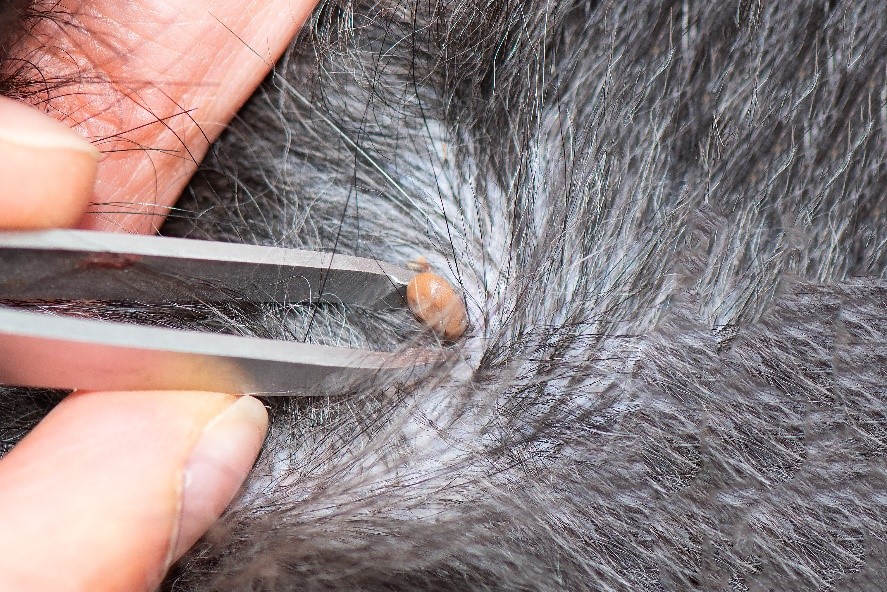Preparing For Tick Season
Protecting Your Pet From Ticks
Spring is here and with blue skies and warm, sunny days it is the perfect time to spend more time outdoors! Although most are harmless, Australia is home to some nasty ticks that can be fatal to your pets. As we approach September, it is important to be vigilant and take extra precautions against tick-borne diseases during this period.
Paralysis ticks are much more than a nuisance and pose a serious threat to the health (and life) of your pets.


Paralysis Tick Season: Dangers & Symptoms
Ticks are a parasite that feeds off their “host” in order to grow, develop and reproduce. Although they are found year-round, ticks prefer warmer, more humid weather making them most active during Spring and Summer.
Australia is home to a wide range of ticks, many of which only leave bite wounds. However, despite its small size, the Paralysis Tick (Ixodes holocyclus) is a dangerous parasite that leaves an estimated 20 000 domestic animals paralysed a year.
With their host animals being mainly native to Australia, these parasites are mostly found in bushland as well as unkempt and overgrown gardens. The paralysis tick can kill pets with one bite by injecting a neurotoxin into the bloodstream, causing gradual muscular paralysis and eventually damaging the major organs.
Prevention is always better than cure, however, it is important to understand the signs of a tick bite so that you can seek treatments for your pet as soon as possible. These symptoms include:
- limping
- Loss of appetite
- Lethargy (lack of energy and enthusiasm)
- Coughing or vomiting
- Difficulty breathing
- Change in Bark or Meow
- Weakness in the hind legs which can lead to overall paralysis
The early stages of a paralysis tick bite are often subtle and hard to discern, but can quickly progress and become more severe. If your dog or cat begins to display these symptoms, it is imperative you contact your vet immediately as early treatment is key to the successful recovery of your pet.


Tick Season And Cats
Many pet owners hold the misconception that cats cannot get ticks. Although it is less likely, it still happens. There is a range of tick prevention products specifically designed for dogs, however, cats are often not afforded the same luxury.
Due to their liver metabolism, they are very sensitive to the insecticides (such as permethrin) in many tick prevention products. This makes choosing the right tick prevention product important. If you are unsure about what is safe for your cat, give your local vet a call so they can recommend the best for your feline friend.

Take the Bite out of Preparing For Tick Season
Too many lives are lost to tick paralysis every year. Fortunately, this deadly condition is largely preventable with a number of precautions. Prevention is far more affordable than the treatments and stress of treating tick paralysis.
Preventative Treatment Routine
It is never too late to begin a preventative routine. There are many measures to take when it comes to treating ticks. These come in the form of topical treatments and tablets, such as NexGard, as well as specially designed collars and shampoos.
If you are unsure about what is best for your pet, consult with your veterinarian, who can advise you on your next steps based on you and your pet’s needs.
Avoid Prone Areas Where Possible
Ticks strive off of shaded, protected areas. During tick season, try to avoid long grass – a prime spot for ticks. If you are walking or hiking with your dog, try to keep away from thick bushy areas and keep an eye on your pet’s coat for any stray parasites.
Your yard is your first line of defence when fighting pesky ticks. By keeping long grass, weed and bushes in your yard to a minimum you are eliminating potential breeding and hiding spots for these pests.
Regular Checks and Baths
Even when you use preventative treatments, it is important to regularly check your pet’s coat for any signs of ticks. This is as simple as patting your pet down and paying close attention to between their toes, armpits and ears.
These checks can be incorporated into your pet’s brushing and washing routine as the use of specially designed tick shampoos can greatly reduce the chance of a bite.


To Remove Or Not To Remove?
Finding a tick can be a nerve-wracking experience and attempting to remove the tick is even scarier! Taking quick action is key. While wearing gloves, use your fingers or a pair of tweezers and grab the tick by its head, as close to the skin as possible. In a twist-and-pluck movement, pull the tick out, taking special care not to leave the head or mouthparts attached.
After removal, keep the tick for identification purposes and dab your pet’s skin with a mild antiseptic. Keep an eye on your furry friend and if they begin to display symptoms similar to above, take your pet immediately to the vet.

Preparing For Tick Season With THCV
Paralysis ticks are a serious threat to the safety and health of Australia’s dogs and cats.
As a pet owner, being prepared and understanding the signs of tick paralysis is critical to ensuring your pet is safe and protected. Despite this, the unexpected can happen, making additional preventative measures just as important.
If you suspect your pet has been bitten by a tick, don’t delay give The House Call Vet a call. Our Mobile Veterinary units and brick-and-mortar clinics are ready to treat your pet.
Standard Clinic Consult are from 8am to 6pm and our House Call Consults are from 7 am to midnight. Open 7 days a week, we are there for you and your pet, no matter what level of care they need.

